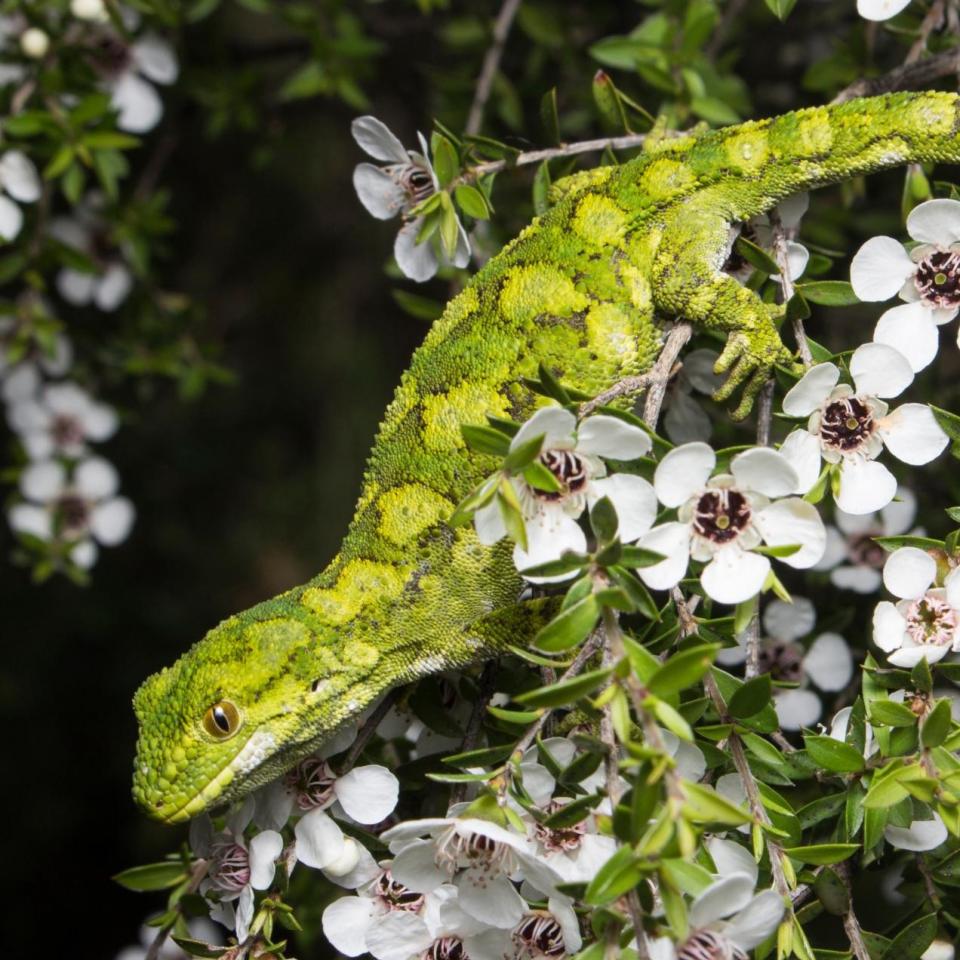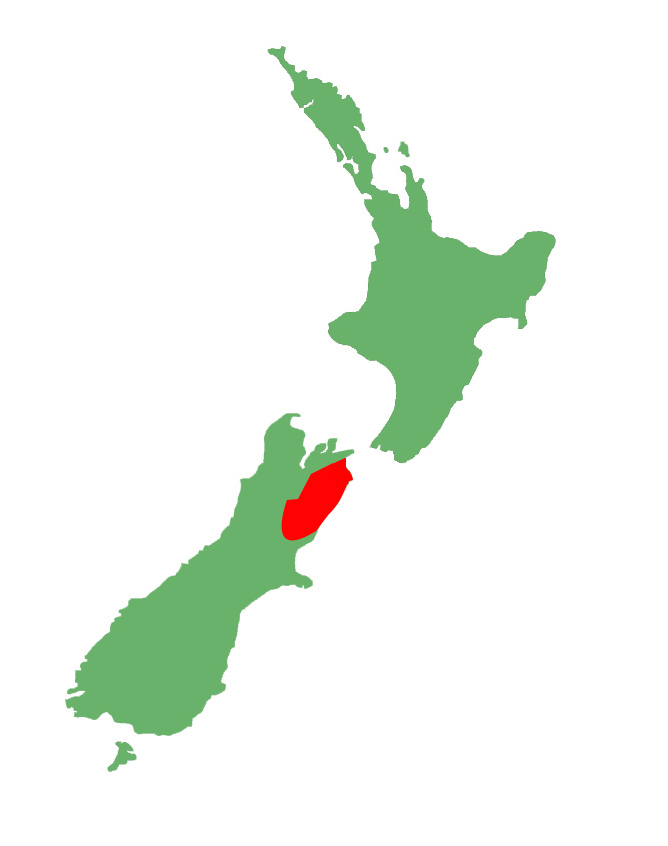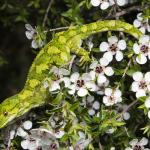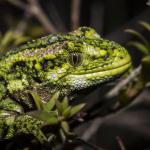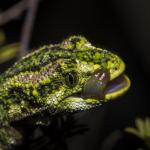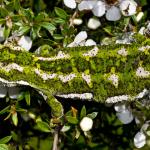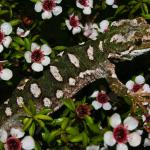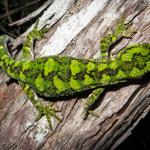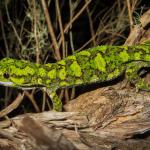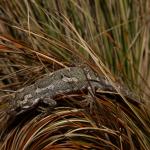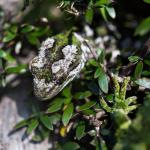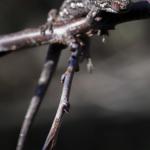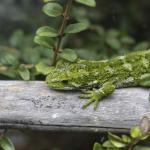- Home
- Herpetofauna Index
- Native
- Naultinus Rudis
Naultinus rudis
Rough gecko
Naultinus rudis
(Fischer, 1882)
Length: SVL up to 79mm, with the tail being longer than the body length
Weight: up to 15.5 grams
Description
An absolutely stunning green gecko species with unique morphology, often found inhabiting the forested regions of the northeastern South Island. Considered by many to be amongst Aotearoa's most enigmatic gecko species, the rough gecko gets its name from the very distinctive raised (or domed), and enlarged scales covering the dorsal surfaces of their body.
In general, rough geckos are characterised by their green to grey dorsal surfaces, which are covered with a large number of raised and enlarged scales. Although oftentimes the background colour is green or grey, the pattern may take on a more mottled appearance being a combination of light and dark greens, browns, and whites. This patterning (usually made up of lighter colours e.g. light green through to white) as with other green geckos can take the form of striping, blotching, diamonds, or any combination of these. The sides of the animals are much the same as the upper surfaces. Their mouth may be bordered below by a broad white stripe which terminates at the back of the mouth. Unlike many of our green geckos, their ventral colour is variable with some individuals (particularly those that are a uniform green) having white to light green stomachs, whilst more patterned or grey individuals range from rich brown through to grey stomachs often with white markings.
Mouth and tongue colour is a key feature in distinguishing between certain South Island Naultinus species, and the rough gecko fits this pattern, having the unique combination of a grey-blue mouth with a pinkish-grey tongue.
Can be differentiated from the majority of South Island green geckos (apart from the Marlborough green gecko (Naultinus manukanus)) based on the presence of large numbers of raised conical scales. May be confused with Marlborough green geckos (Naultinus manukanus) from the southern part of their range, which may exhibit a similar abundance of raised scales. However, they are geographically separated by the Wairau river with rough geckos occurring south/east of that dividing line.
Life expectancy
Rough geckos have been recorded reaching ages of ~50 years in captivity.
Captive green geckos have frequently been known to live for upwards of 25 years, with some individuals topping the records at 50+ (D. Keal pers. comm 2016). In the wild, green geckos have been recorded as reaching a minimum of ~15 years, although it is likely to be more than this given that the population in question was only monitored from 2009, and those animals are still alive (C. Knox pers. comm 2021).
Distribution
Restricted to the northeastern South Island, occurring east of the Wairau River down through to northern Canterbury (may be bounded by the Waiau Uwha River).
Ecology and habitat
The rough gecko appears to be cathemeral (active both day and night) in nature, although predominantly considered diurnal (day-active), due to its strongly heliothermic nature (being an avid sun basker). As with all members of the Naultinus genus they are primarily arboreal (tree-dwelling), although can at times be found quite low to the ground in prostrate (ground-hugging) vegetation. Although seldom seen on the ground, males can be found travelling between trees in search of mates during the breeding season. As with all green geckos, they possess a strongly prehensile tail which acts as a third-limb/climbing aid when moving through shrubs and trees. They are known to mouth-gape and produce a barking sound as a defensive behaviour against potential predators.
Being an arboreal species, rough geckos are closely associated with forested habitats, and thus inhabit a wide variety of forest types in the northeastern South Island, including swamps, scrubland, and mature forest. They appear to favour scrubby/regenerating habitats, but this may be a result of the relative ease of access, and amount of search effort that these sites garner.
Social structure
The rough gecko is solitary in nature, although can be found at fairly large densities in some habitats. Males show aggressive behaviour toward congeners, especially during the breeding season, and this is easily observable with many males showcasing scarring over their bodies. Mate guarding seems to occur in this species, with males often found in close proximity to females prior to birthing. Although independent at birth, neonates (babies) are often found together and close to the mother for the first few months of life.
Breeding biology
Like all of Aotearoa's gecko species, the rough gecko is viviparous, giving birth to one or two live young annually, from around Late February through to April.
As is the case with many lizard species, mating in green geckos may seem rather violent with the male repeatedly biting the female around the neck and head area. Sexual maturity is reached between 1.5 to 2 years.
Diet
Rough geckos are omnivores. They are primarily insectivorous in nature, but are also known to feed on the nectar, and small fruits of several plant species, and the honeydew of scale insects when they are seasonally available. Being arboreal in nature, their invertebrate prey tends to be predominantly composed of flying insects (moths, flies, beetles), and small spiders.
Disease
The diseases and parasites of Aotearoa's reptile fauna have been left largely undocumented, and as such, it is hard to give a clear determination of the full spectrum of these for many species.
The rough gecko, as with many of our other Naultinus species, is a host for at least one species of endoparasitic nematode in the Skrjabinodon genus (Skrjabinodon poicilandri), as well as at least one strain of Salmonella. Similarly, it is unlikely to be a host for ectoparasitic mites in the wild. Captive collections have been known to host mites, but these have likely shifted onto the animals from different species e.g. Mokopirirakau, Dactylocnemis, and Hoplodactylus geckos.
Wild green geckos have been found with pseudobuphthalmos (build-up of liquid in the spectacle of the eye) and Disecdysis (shedding issues).
Conservation status
Listed in the most recent threat classification as 'Threatened - Nationally Endangered', due to a mix of land development/clearance of habitat, predation by mammalian predators, and competition/predation from Vespula wasps.
Interesting notes
The specific name 'rudis' (meaning rough in Latin) references the unique scalation found on this species. The common name also refers to the rough appearance that the scales give it.
Māori first described the vocalisations of green geckos to Europeans as being like kata - laughter, being a repetitive call somewhere between a bark and a squeak.
The rough gecko is the sister species to the Marlborough green gecko (Naultinus manukanus). The starred gecko (Naultinus stellatus) is their next closest relative, whilst the West Coast green gecko (Naultinus tuberculatus) is the sister to the rest of the group.
Interestingly, genetics from the Lewis Pass form of the West Coast green gecko (Naultinus tuberculatus) indicate historical introgression (hybridisation) between these two species.
References
Gill, B.J., & Whitaker, A.H. (2007). New Zealand frogs and reptiles. Auckland: David Bateman Ltd.
Jewell, T. (2011). A photographic guide to reptiles and amphibians of New Zealand. Auckland: New Holland Publishers.
Robb, J. (1980). Three new species of gekkonid lizards, genera Hoplodactylus Fitzinger and Heteropholis Fischer, from New Zealand. National Museum of New Zealand records 1(19), 305-310.
van Winkel, D., Baling, M. & Hitchmough, R. (2018). Reptiles and Amphibians of New Zealand: A field guide. Auckland: Auckland University Press, 376 pp.

